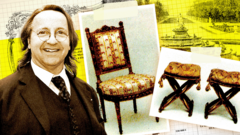The recent court case has unveiled a scandal that rocked the French antiques scene, involving two distinguished craftsmen who managed to create and sell fake chairs previously believed to be royal treasures from the Palace of Versailles. Specifically, these chairs were supposedly made for Marie Antoinette.
In the early 2010s, these eye-catching chairs hit the French antiques market, quickly becoming the center of attention. Tagged as “national treasures” by the French government, they were ultimately sold to Qatari Royal Mohammed bin Hamad Al Thani for €2 million (£1.67 million). Legend has it, these chairs were part of an astonishing array of 18th-century royal furnishings.
Unfortunately for buyers, the veneer of grandeur was merely a façade. In 2016, the furniture was exposed as forgeries, leading to a high-profile trial for the creators, Georges “Bill” Pallot and Bruno Desnoues, both highly regarded in their fields. Their operation was a peculiar blend of artistry and deception that began as a joke in 2007. They embarked on a journey crafting replicas, using materials sourced from various auctions, which they manipulated to appear authentically aged.
Pallot, an established expert in 18th-century furniture, and Desnoues, a decorated cabinetmaker, managed to sell their creations through established galleries, leaving collectors and institutions deceived for years. The prosecution estimated they profited over €3 million, a shocking figure highlighted by the lifestyle of associates who raised suspicions of their financial activities, leading to the unraveling of this grand scheme.
Despite admitting to their involvement, Pallot and Desnoues maintained that they acted with the best of intentions, leading to a discussion on the need for tighter regulations in the art market. As a fallout, the case has also raised questions regarding the accountability of galleries like Galerie Kraemer for their role in the fraudulent sales.
In the midst of ongoing trials, the implications stretch far beyond these two artisans, placing a spotlight on the need for authenticity checks within the antiques business and how trust can be manipulated for profit. As investigations continue, the very idea of art and its authenticity comes under scrutiny in an industry filled with numbers and prestige that can sometimes mask a darker side.
In the early 2010s, these eye-catching chairs hit the French antiques market, quickly becoming the center of attention. Tagged as “national treasures” by the French government, they were ultimately sold to Qatari Royal Mohammed bin Hamad Al Thani for €2 million (£1.67 million). Legend has it, these chairs were part of an astonishing array of 18th-century royal furnishings.
Unfortunately for buyers, the veneer of grandeur was merely a façade. In 2016, the furniture was exposed as forgeries, leading to a high-profile trial for the creators, Georges “Bill” Pallot and Bruno Desnoues, both highly regarded in their fields. Their operation was a peculiar blend of artistry and deception that began as a joke in 2007. They embarked on a journey crafting replicas, using materials sourced from various auctions, which they manipulated to appear authentically aged.
Pallot, an established expert in 18th-century furniture, and Desnoues, a decorated cabinetmaker, managed to sell their creations through established galleries, leaving collectors and institutions deceived for years. The prosecution estimated they profited over €3 million, a shocking figure highlighted by the lifestyle of associates who raised suspicions of their financial activities, leading to the unraveling of this grand scheme.
Despite admitting to their involvement, Pallot and Desnoues maintained that they acted with the best of intentions, leading to a discussion on the need for tighter regulations in the art market. As a fallout, the case has also raised questions regarding the accountability of galleries like Galerie Kraemer for their role in the fraudulent sales.
In the midst of ongoing trials, the implications stretch far beyond these two artisans, placing a spotlight on the need for authenticity checks within the antiques business and how trust can be manipulated for profit. As investigations continue, the very idea of art and its authenticity comes under scrutiny in an industry filled with numbers and prestige that can sometimes mask a darker side.


















